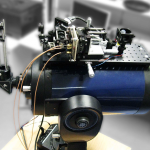
SatComScope
Project focus
- Analysis of free-space optical communication properties and requirements.
- Development and integration of an adaptive optical compensation system for free-space optical communication into a small telescope.
- Dual stage actuation of the adaptive optical system and the telescope mount.
Description
This project aims to integrate adaptive optics (AO) technology into small to medium-sized telescope systems of the industrial partner, ASA Astrosysteme, in order to enable free space optical (FSO) communication between satellites and optical ground stations. Compared to radio-frequency communication, this yields a potential increase of the data rate of more than 1 order of magnitude, while simultaneously significantly reducing the emitting power and weight on the satellite. Furthermore, optical frequencies do not require licensing.
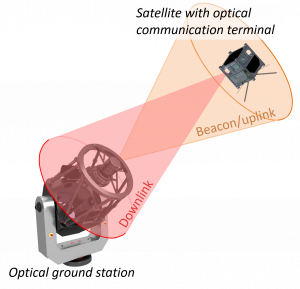
Principle of optical satellite communication. Precise pointing is required on both terminals.
Based on an integrated, mechatronic approach, the proposed AO system focuses on high performance and cost efficient realization to enable FSO communication with small to medium-sized telescopes operating as optical ground stations. The resulting telescope system will provide a stable laser-link between corresponding satellites and the developed optical ground station, enabling FSO communication at unprecedented data rates, while simultaneously reducing energy consumption of the emitter at the satellite.
System analysis
Atmospheric turbulences, as well as vibrations of the telescope system, significantly affect the performance of optical communication links. To ensure a reliable satellite link with high data-rates and low BER, these disturbances are compensated by means of an adaptive optical system. A key trade-off is the system complexity vs. compensation performance. Especially for small telescopes a shift towards low-order aberrations is visible. All above tip-tilt aberrations may contribute up to 80% of the total wavefront error, hence requiring a powerful tip-tilt compensation system.
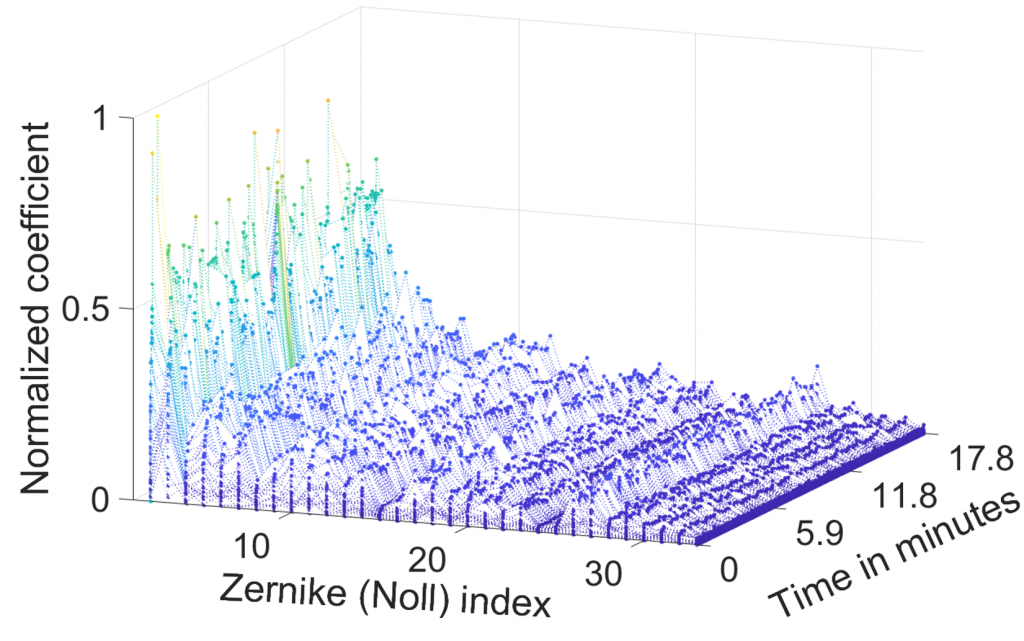
Measured wavefront error statistics over time acquired with a 30 cm telescope in Vienna using the star Actrurus. A clear dominance of low-order aberrations is visible
“Ultra low earth orbit (U-LEO)” link
To evaluate various AO approaches a reflective FSO communication link is available between two buildings of TU Wien. A two way distance of 600 m in urban environment provides harsh conditions for the developed systems.
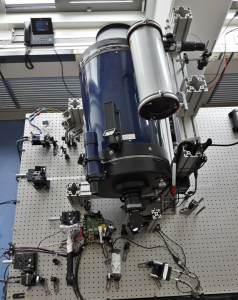 Adaptive optical setup for free-space optical communication using the U-LEO link. A 35 cm SC-telescope as well as a, 10 cm Newton are available for communication experiments. |
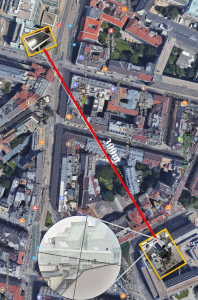 Ultra low earch orbit communication link over a distance of 600 m between two buildings of TU Wien.
|
Optical system for U-LEO link
A 35 cm SC-telescope is used as receiving antenna for the urban link. A combination of tip-tilt compensation (FSM+QPD) and adaptive optical system (DM + WFS) is used to test various correction approaches.
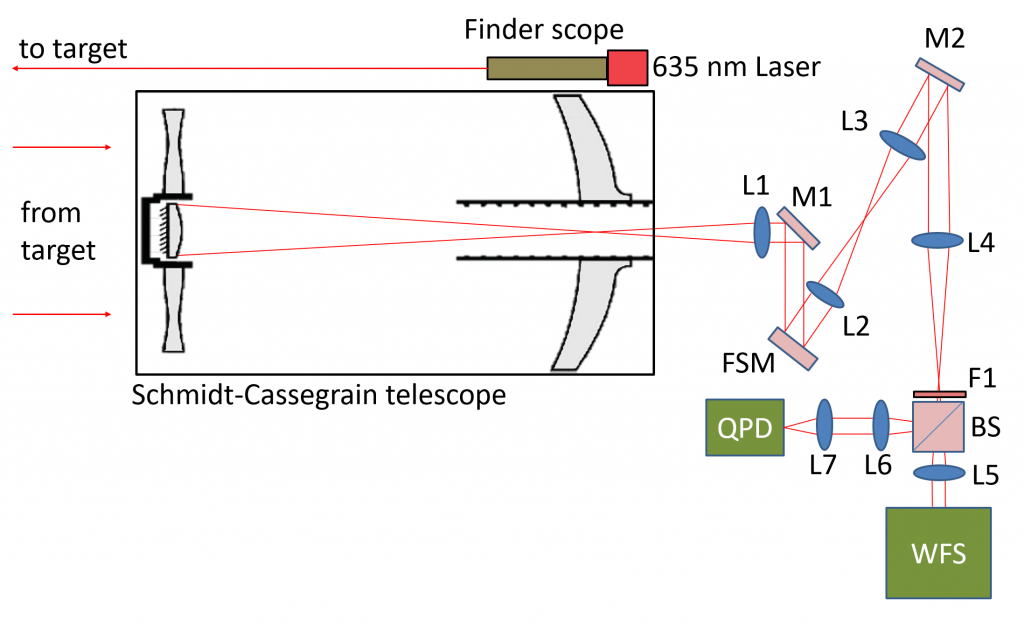
Schematic setup of the U-LEO optical system including a FSM, a deformable mirror (M2), a quad-photodiode (QPD) and a wavefront sensor (WFS). The 35 cm SC-telescope is used for reception.
Tip-tilt correction for the U-LEO link reveals a significant improvement of the RMS errors, as shown below. The blue curves show the movement of the received spot on the QPD without correction. After 30 s correction is enabled and the deviations are compensated.
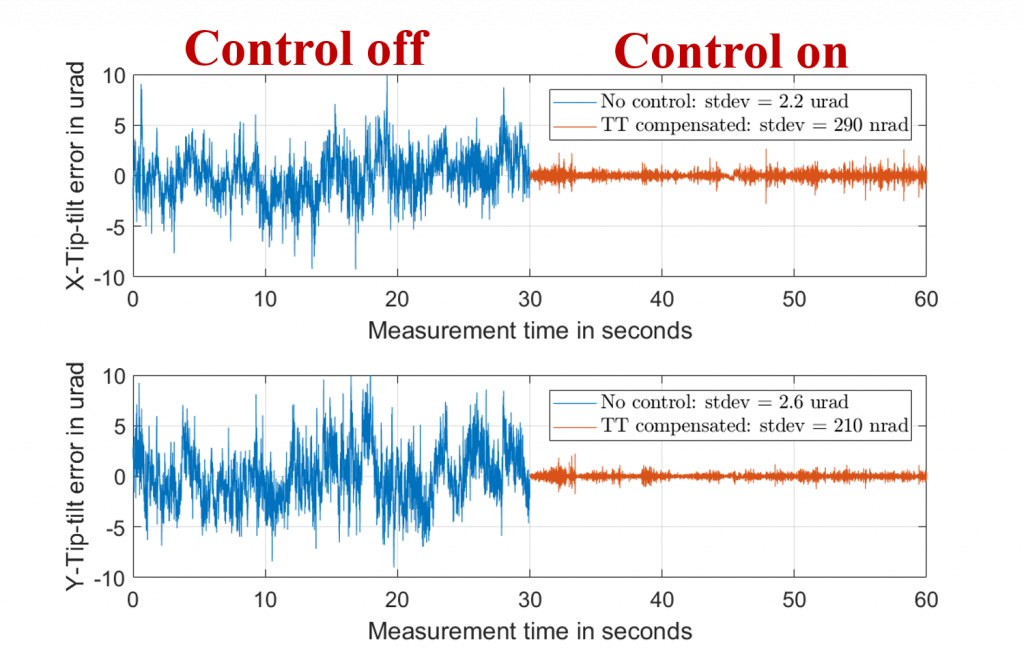
Tip-tilt control comparison of the U-LEO link. With out tip-tilt compensation an standard deviation of more than 2 urad is visible. If tip-tilt compensation is enabled, the error is reduced by up to a factor of ten, keeping the center of the received spot on the detector area.
Mobile optical bench
To enable evaluation of the developed tip-tilt compensation systems with various telescopes at different sites, a mobile version of the optical system is developed. It is designed, to be easily adapted and attached to telescope systems at TU Wien as well as at ASA Astrosysteme.
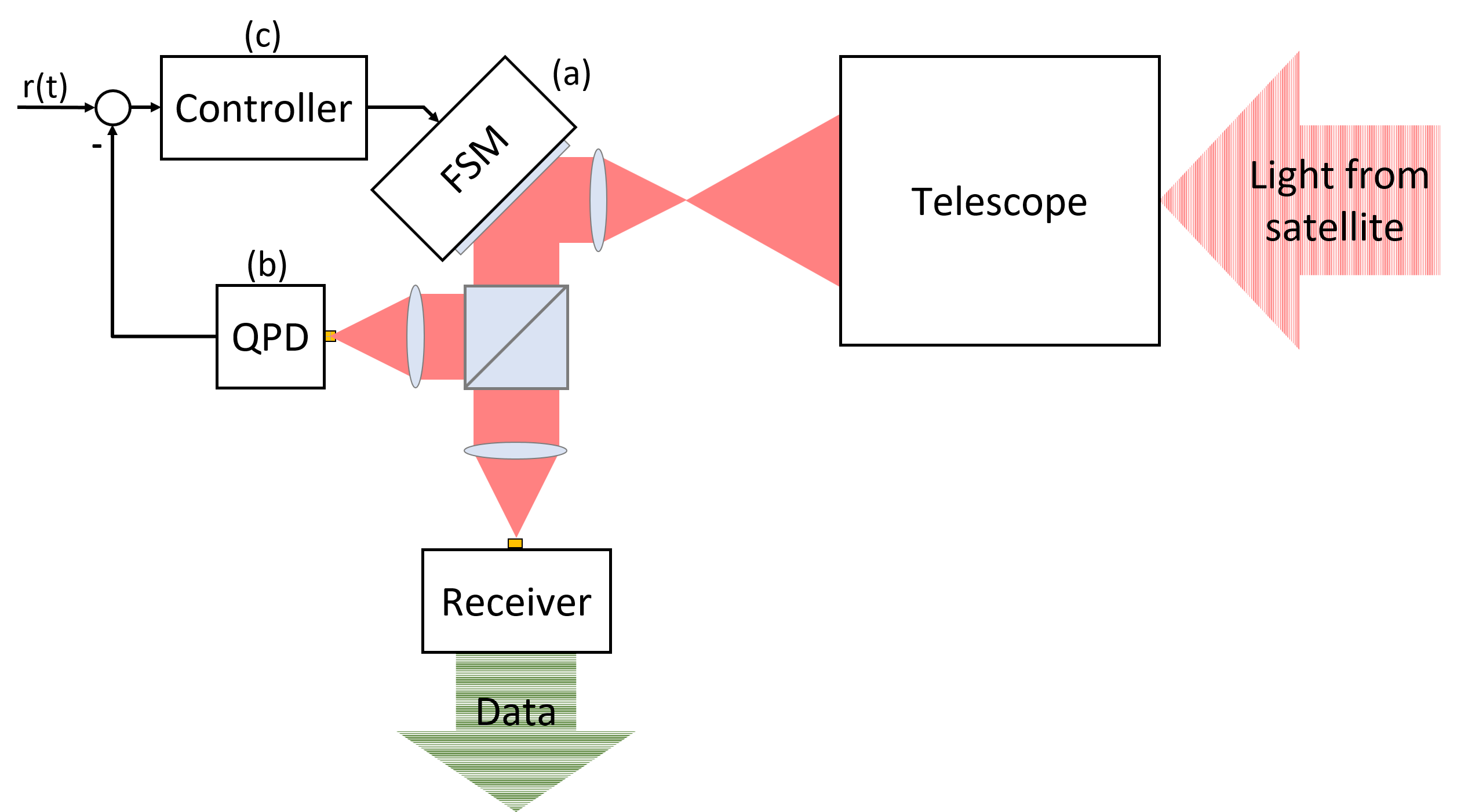
Schematic overview of the mobile optical bench for tip-tilt compensation.

Mobile optical bench attached to a ASA 12″ Newton telescope (left) and to a ASA AZ800 RC-telescope (right).
Tip-tilt compensation for LEO object tracking
Below two videos recorded during the same pass of the LEO object COSMOS 2315 are shown for comparison. Without tip-tilt compensation and open-loop tracking of the telescope mount an offset as well as fluctuations of the spot position are visible. If tip-tilt control is enable, both offset and fluctuations are compensated, keeping the center of the spot on a communication detector.
Video of a LEO object acquired with the AZ800 telescope without and with compensation.
The pointing error as well as the position fluctuations of the spot are significantly reduced.
Applications
- Optical satellite communication
- Astronomy applications
- Satellite laser ranging
Related Publications
- A. Sinn, T. Riel, F. Deisl, S. Schachner, and G. Schitter, High-bandwidth tip-tilt vibration compensation in telescope systems, in Proceedings of the Joint Conference 8th IFAC Symposium on Mechatronic Systems (MECHATRONICS 2019), and 11th IFAC Symposium on Nonlinear Control Systems (NOLCOS 2019), 2019.
[BibTex] [Download]@InProceedings{TUW-282537, author = {Sinn, Andreas and Riel, Thomas and Deisl, Florian and Schachner, Stephan and Schitter, Georg}, title = {High-bandwidth tip-tilt vibration compensation in telescope systems}, booktitle = {Proceedings of the Joint Conference 8th IFAC Symposium on Mechatronic Systems (MECHATRONICS 2019), and 11th IFAC Symposium on Nonlinear Control Systems (NOLCOS 2019)}, year = {2019}, volume = {52/15}, note = {Vortrag: Joint Conference 8th IFAC Symposium on Mechatronic Systems (MECHATRONICS 2019), and 11th IFAC Symposium on Nonlinear Control Systems (NOLCOS 2019), Wien; 2019-09-04 -- 2019-09-06}, doi = {10.1016/j.ifacol.2019.11.733}, url = {https://www.sciencedirect.com/science/article/pii/S2405896319317276?via%3Dihub}, journal = {IFAC-PapersOnLine/Elsevier}, keywords = {Vibration compensation, telescopes, optical communication, fast steering mirror, tip-tilt compensation}, numpages = {6} }
- A. Sinn, T. Riel, P. Kremsner, and G. Schitter, Analysis of tip-tilt compensation for reflective free-space optical satellite communication, in Free-Space Laser Communications XXXI, 109101G, 2019.
[BibTex] [Download]@InProceedings{TUW-282538, author = {Sinn, Andreas and Riel, Thomas and Kremsner, Peter and Schitter, Georg}, title = {Analysis of tip-tilt compensation for reflective free-space optical satellite communication}, booktitle = {Free-Space Laser Communications XXXI}, year = {2019}, address = {109101G}, publisher = {SPIE}, note = {Vortrag: SPIE Photonics West 2019, San Francisco, California, USA; 2019-02-02 -- 2019-02-07}, doi = {10.1117/12.2506472}, keywords = {optical satellite communication, adaptive optics, tip-tilt compensation, dynamic error budgeting}, numpages = {12} }
- F. Deisl, Dual stage actuation of a telescope mount and a tip-tilt mirror for free-space optical communication, 2019.
[BibTex]@MastersThesis{TUW-279640, author = {Deisl, Florian}, title = {Dual stage actuation of a telescope mount and a tip-tilt mirror for free-space optical communication}, school = {E376}, year = {2019} }
- A. Sinn, T. Riel, F. Deisl, and G. Schitter, Tip-tilt vibration compensation: A system analysis, in Proceedings of 2017 Spring Topical Meeting on Precision Engineering and Optics: What are the Limits of Precision, and How to Characterize Them?, 2017, p. 42–47.
[BibTex]@inproceedings{TUW-261675, author = {Sinn, Andreas and Riel, Thomas and Deisl, Florian and Schitter, Georg}, title = {Tip-tilt vibration compensation: A system analysis}, booktitle = {Proceedings of 2017 Spring Topical Meeting on Precision Engineering and Optics: What are the Limits of Precision, and How to Characterize Them?}, year = {2017}, pages = {42--47}, note = {Vortrag: ASPE 2017 Spring Topical Meeting, Tucson (USA); 2017-04-24 -- 2017-04-25} }
- A. Sinn, T. Riel, F. Deisl, R. Saathof, and G. Schitter, Low-Power Reflective Optical Communication System for Pico- and Nano-Satellites, in AMOS 2016 Proceedings, 2016, p. 1403–1410.
[BibTex] [Download]@InProceedings{TUW-252989, Title = {Low-Power Reflective Optical Communication System for Pico- and Nano-Satellites}, Author = {Sinn, Andreas and Riel, Thomas and Deisl, Florian and Saathof, Rudolf and Schitter, Georg}, Booktitle = {AMOS 2016 Proceedings}, Year = {2016}, Note = {Posterpr{\"a}sentation: Advanced Maui Optical Space Surveillance Technologies Conference (AMOS) 2016, Wailea, Hawaii (USA); 2016-09-20 -- 2016-09-23}, url = {https://www.semanticscholar.org/paper/Low-Power-Reflective-Optical-Communication-System-Sinn-Riel/bfe4fcba68313914449b8ab2ff0d8526fdee820e#citing-papers}, Pages = {1403--1410} }
Project partners
Funding
Contact
Univ.-Prof. Dipl.-Ing. Dr.sc.techn. Georg SchitterDipl.-Ing. Andreas Sinn
Project Staff
Dipl.-Ing. Mathias PoikM.Sc. Christian Schwär
Dipl.-Ing. Andreas Sinn
Peter Kremsner